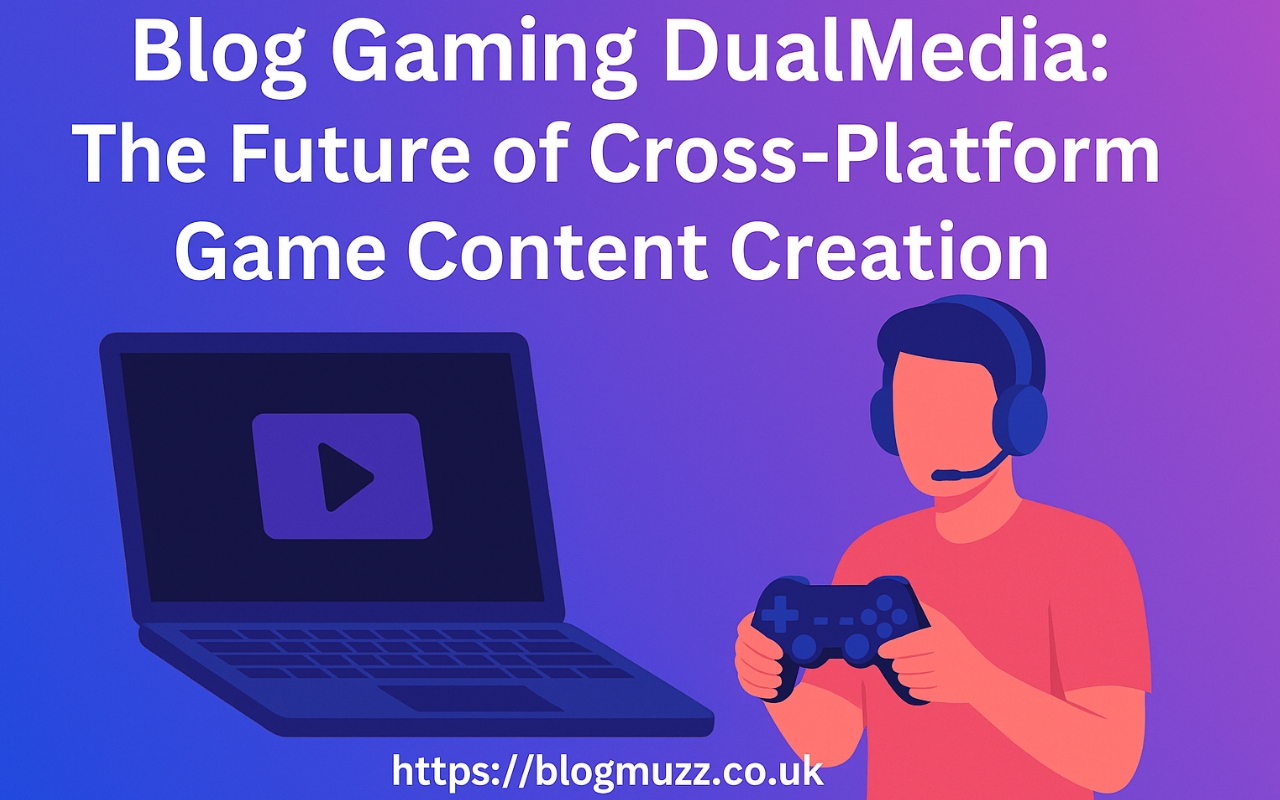Understanding Blog Gaming DualMedia: The Fusion of Two Digital Worlds
The term blog gaming dualmedia refers to the powerful convergence of gaming content and multimedia blogging. Traditionally, blogging focused heavily on text, with an occasional image or embedded video. However, in the gaming industry—one that thrives on visual immersion and community-driven experiences—there’s been a massive transformation in how content is created and consumed. DualMedia in this context means integrating both blogging and multimedia—videos, podcasts, livestreams, infographics, and even interactive media—to create rich, engaging content across platforms.
The rise of content creators who are both bloggers and streamers, or bloggers and YouTubers, exemplifies this trend. Gaming blogs are no longer just walkthroughs or written reviews—they are multi-platform ecosystems, filled with TikTok snippets, Twitch replays, podcast discussions, and more. This is the essence of blog gaming dualmedia—a new form of hybrid storytelling that meets gamers wherever they are: on YouTube, Medium, Discord, Reddit, or even in the metaverse.
Why Traditional Game Blogging Is Evolving
In the early 2000s, game blogging was mostly written reviews, top 10 lists, cheat codes, and longform opinion pieces hosted on sites like Blogspot or WordPress. While these still have their place, they don’t meet the expectations of modern gamers who demand dynamic, fast-paced, and immersive content.
The evolution is happening because of several factors:
- Video content dominance on platforms like YouTube and TikTok.
- Livestreaming popularity through Twitch and Kick.
- Algorithm changes on Google and social platforms favoring rich media.
- Mobile-first consumption, where people prefer watching quick clips over reading long posts.
- Monetization opportunities with affiliate links, paid memberships, Patreon, and NFTs.
Because of these shifts, blog gaming dualmedia has become a necessity, not an option, for content creators who want to build influence, monetize their work, and engage larger audiences.
The Rise of Cross-Platform Game Content Creators
Today’s most successful gaming influencers aren’t confined to a single platform. Instead, they maintain a presence across blogs, video platforms, social media, and podcast networks. This cross-platform strategy enables greater reach, better audience retention, and increased revenue streams.
Consider this example:
- A content creator writes an in-depth blog post on Elden Ring builds.
- They then create a YouTube video breaking down the builds in action.
- On Twitch, they live-stream gameplay testing those builds.
- Short TikTok clips and Instagram Reels showcase highlights.
- A podcast episode discusses community strategies and feedback.
All this content is interlinked—boosting SEO, feeding social media algorithms, and building authority. This is the heart of blog gaming dualmedia—a strategic fusion of content mediums for maximum impact.
Tools and Platforms Powering the Blog Gaming DualMedia Movement
To thrive in dualmedia content creation, creators must leverage a combination of tools and platforms. Each has a specific role in shaping, hosting, or amplifying gaming content.
Blogging Platforms:
- WordPress: Still the #1 for blogging due to its flexibility.
- Ghost: Popular with newsletter-driven gaming blogs.
- Substack: For combining blogging with email marketing.
Video Platforms:
- YouTube: Essential for guides, reviews, and let’s plays.
- TikTok: Great for viral gaming tips and quick reactions.
- Twitch: Live gameplay, Q&As, and community events.
Audio Platforms:
- Spotify/Apple Podcasts: For deep-dive discussions, lore breakdowns.
- Anchor.fm: Makes publishing podcasts easy.
Design and Multimedia Tools:
- Canva: For creating blog banners and thumbnails.
- OBS Studio: For livestreaming.
- DaVinci Resolve/Adobe Premiere: For professional video editing.
Social Engagement:
- Discord: Hosting a community around your blog/gaming channel.
- Reddit: Driving traffic and feedback from niche gaming subreddits.
- X (Twitter): Real-time updates and content promotion.
Using these tools in sync lets creators build a robust blog gaming dualmedia presence that caters to all types of followers.
Monetizing Your Blog Gaming DualMedia Presence
One of the most powerful aspects of the dualmedia model is monetization. Unlike traditional blogs that relied on banner ads and affiliate links, today’s cross-platform creators earn income from multiple sources:
- Ad Revenue: YouTube ads, blog display ads via AdSense or Mediavine.
- Affiliate Marketing: Linking to games, hardware, or services via Amazon, Humble Bundle, etc.
- Sponsorships: Brands paying to be featured in blogs/videos.
- Subscriptions: Patreon, YouTube memberships, Buy Me a Coffee.
- Merchandising: Selling custom apparel or gaming accessories.
- NFTs & Web3: Offering digital collectibles tied to your gaming content.
- Courses & eBooks: Teaching others how to grow as creators.
A dualmedia creator diversifies income across platforms—hedging against algorithm changes and platform shutdowns, and building a sustainable creative business.
SEO and Discoverability in a DualMedia Gaming Strategy
A key pillar of success in blog gaming dualmedia is SEO (Search Engine Optimization). But unlike traditional SEO that focused solely on written content, today’s discoverability strategies span video SEO, social SEO, and podcast SEO.
Here’s how:
- Blog SEO: Use gaming keywords, long-tail search phrases, and internal linking.
- Video SEO: Optimize YouTube titles, descriptions, and closed captions.
- Social SEO: Use trending hashtags, ALT text, and geo-targeted tags.
- Audio SEO: Publish transcripts of podcast episodes for better indexing.
Moreover, repurposing one type of content into another format boosts SEO exponentially. For example:
- Turn a blog post into a YouTube script.
- Convert podcast interviews into blog Q&As.
- Use Twitch highlights in Instagram Reels.
This strategy ensures your content is omnipresent and discoverable, maximizing organic traffic across all channels.
Challenges in Blog Gaming DualMedia and How to Overcome Them
While the rewards of dualmedia are high, there are considerable challenges to consider:
- Time and energy: Managing multiple platforms is time-consuming.
- Creative burnout: Constantly producing varied content can drain passion.
- Platform dependency: A ban or algorithm update can wipe out traffic overnight.
- Equipment costs: High-quality video/audio production requires investment.
- Audience fragmentation: Followers may prefer one platform over another.
To overcome these, creators should:
- Use content batching to create in advance.
- Hire a virtual assistant or editor for repetitive tasks.
- Focus on core platforms, then expand gradually.
- Build an email list and Discord server to stay connected with fans directly.
Sustainability and balance are crucial in this evolving ecosystem.
Case Studies: Creators Who Mastered Blog Gaming DualMedia
Let’s look at real-world examples of creators who exemplify the blog gaming dualmedia model:
1. Zanny (YouTube + Patreon + Merch)
Known for his comedic War Thunder and Halo content, Zanny writes detailed video scripts, engages audiences through Discord, and sells branded merch while posting blog-style game lore breakdowns on Patreon.
2. AestheticGamer (Dusk Golem) (Twitter/X + Longform Blogs)
While primarily known on Twitter for leaks and rumors, Dusk Golem supports his insights with well-researched blog articles. His success lies in cross-pollination between fast and slow media.
3. Jessie Gender (YouTube + Podcast + Blog)
Covering narrative games and social issues in gaming, Jessie integrates video essays with podcast discussions and blog writeups, cultivating a thoughtful and loyal fanbase.
These creators prove that strategic multi-format content can expand reach, authority, and income when done right.
The Future of Blog Gaming DualMedia
Looking forward, AI, AR/VR, and blockchain will further transform blog gaming dualmedia. Expect the rise of:
- AI-driven content assistants that help write blogs or generate scripts.
- Interactive blog formats embedded with playable demos or AR content.
- Decentralized content hosting through Web3 and crypto-backed communities.
- Immersive blogs in VR—imagine reading a game review inside a 3D version of the game world.
Creators who embrace innovation while staying rooted in storytelling and audience connection will lead the charge. The future of blog gaming dualmedia is not just cross-platform—it’s cross-reality.
Conclusion: Start Your Blog Gaming DualMedia Journey Today
The era of siloed game content is over. To thrive in the digital age, creators must adopt a blog gaming dualmedia approach—one that fuses written storytelling with rich media, cross-platform publishing, and community building.
Whether you’re a solo blogger, a hobbyist gamer, or a growing brand, now is the time to expand beyond traditional content and explore new formats. Start small—maybe by turning one blog into a podcast, or one review into a TikTok—and scale up from there.


